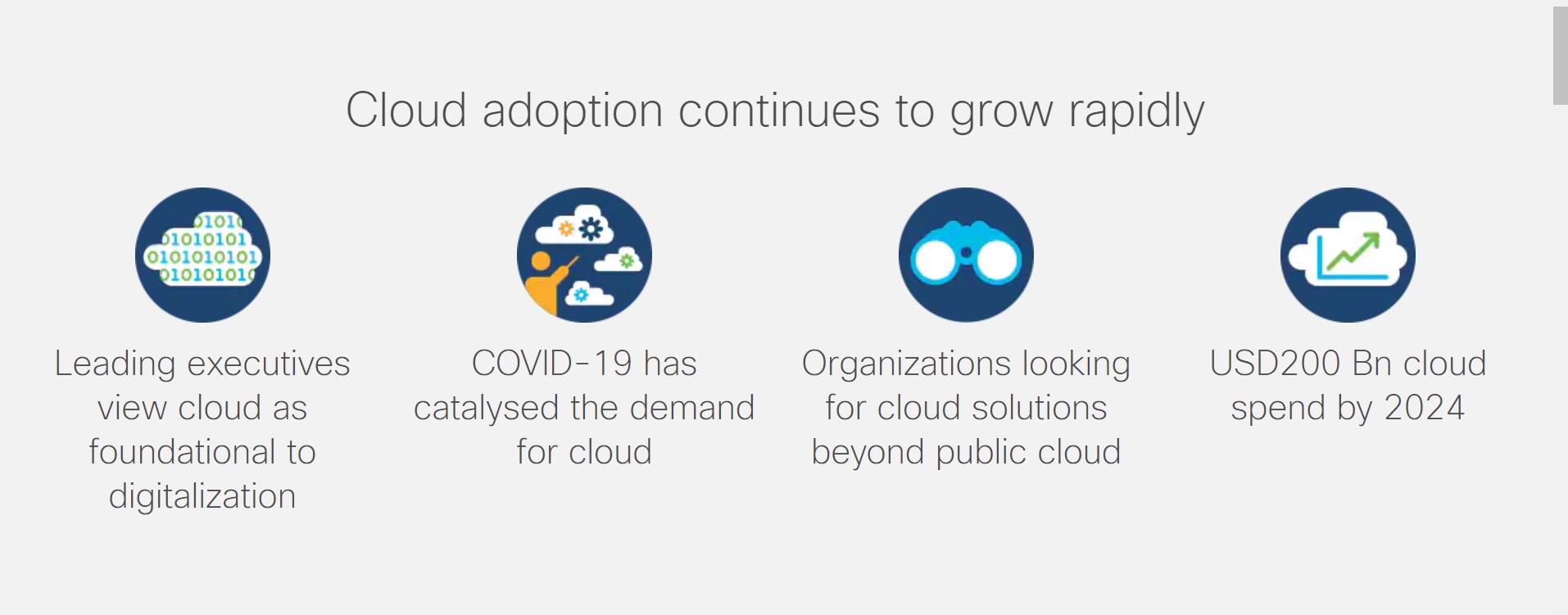New report from Cisco and BCG examines cloud adoption strategies and imperatives as organizations define their unique cloud journey to achieve business value
Organizations across Asia Pacific are increasingly turning to cloud innovations as the foundation for their digitalization efforts, in a strategic move to become faster, leaner, and better at delivering results for their customers, a new study by Cisco and the Boston Consulting Group (BCG) shows.
Titled The Future of Cloud in Asia Pacific, the report highlights that overall cloud spending is expected to reach USD200 billion in the region by 2024 according to Gartner, with investment into the cloud growing at a compound annual growth rate (CAGR) of over 20% since 2018. Singapore is among the top three markets in Asia Pacific with the largest overall IT spend across applications, platforms, infrastructure, and services. Across ASEAN, economies such as Indonesia, Malaysia, the Philippines, and Vietnam will lead the pack in terms of cloud spending growth at a CAGR of 25% by 2024.
Naveen Menon, President, ASEAN at Cisco, said, “Cisco takes a cloud-neutral approach to capture the many benefits that cloud technologies offer. Our full-stack observability capabilities enable our customers to see and manage their infrastructure and applications, connect securely, optimize operations, and improve application experience. Looking ahead, cloud investments will continue to dominate boardroom conversations, with enterprises being the chief architects in their own cloud journey, and in shaping the future of cloud.”
Findings from the study further reveal how organizations in the region are optimizing a mix of public, private and hybrid cloud environments, based on their unique digital, operational, and business needs and several other factors, including regulatory concerns, risk appetite, geographical expansion, and data needs. Notably, the real challenge in today’s digital era is understanding how to manage this transition to cloud in a smooth, seamless, and secure manner.
Prasanna Santhanam, Managing Director and Partner, Singapore, BCG, said, “There is no one-size-fits-all solution in the cloudification roadmap. Business and IT leaders need to be strategic and mindful when navigating the intricacies of cloud innovations and consider the benefits, challenges and risks associated with each strategy in the mid- to long-term. As the focus shifts towards rebuilding better and emerging stronger in the next normal, cloud innovations will no doubt form an integral part of robust business continuity plans.”
The report identifies five archetypes of organizations based on their cloudification journey – namely, the Digital Native, Cloud Optimizer, Cloud Pragmatist, Cautious Adopter and Cloud Onlooker – and explores the characteristics of each archetype to provide analysis and context behind their cloud strategy.

- Digital Native: Organizations that were born in the cloud and built from the ground up on the cloud. Cloud is fully embedded in the business, which is primarily driven by digital- and cloud-first strategies. Public cloud has always been the default choice for them, and through their cloud capabilities, they are able to respond swiftly to the dynamic business landscape with great agility.
- Cloud Optimizer: Such organizations are at the forefront of digital transformation initiatives, having moved away from outdated legacy systems to the cloud. They have mature cloud systems in place, and typically take a public cloud first approach.
- Cloud Pragmatist: Organizations that are embracing cloud, but generally prefer private over public cloud due to concerns over data and workloads. Due to their priority in maintaining control over their data, risks and costs, public cloud is used to a limited extent for non-business critical workloads, while private cloud is utilized as a strategic asset.
- Cautious Adopter: While digital is rising on their agenda, these organizations take a project-based approach to cloud adoption and do not have an enterprise-wide cloud strategy. Leaders have yet to fully understand and embrace the benefits of cloud offerings, resulting in a lack of strategic direction to define a cloud vision.
- Cloud Onlooker: These organizations do not currently consider cloud as a strategic advantage for their business goals, but as another form of digital infrastructure. They have no active plans to adopt cloud in their business model and strategy, but leaders could introduce isolated cloud solutions if they believe that to be beneficial to the organization.
Based on these five archetypes, the report provides a working tool for business leaders to develop a better strategy to tailor their cloudification journey.
At a virtual media briefing Mr. Menon elaborated, “Each organization’s path will look different, depending on their unique needs and focus areas as they develop their post-pandemic roadmap. While cloud service providers have in the past defined cloud as the aspiration and end goal for customers, it has become abundantly clear that the cloud journey needs to be personalized and tailored to the business and its sector. As organizations navigate the hybrid cloud world and distributed workforce of the future, the challenge is ensuring this shift to cloud is managed efficiently and securely.”
The study illustrates four stages of cloud adoption in which organizations can map their journey against. While organizations do not adhere to a standard, homogenous timeline, they typically require a ‘trigger’ to move on to the next stage. For instance, this could come in the form of shifts in business demand or changes in the organization’s digital agenda.
- Stage 1 – Initial/Ad-hoc: In this initial stage, the organization is not actively pursuing cloud innovations, but might be implementing it on an ad-hoc basis.
- Stage 2 – Experiment: In this phase, cloud solutions are largely experimental and on-premises, with a focus on the improvement of customer experience or leveraging analytics for better insights.
- Stage 3 – Scale: In this phase, cloud strategy is organization-wide and well-defined, with the use of cloud integrated in core business systems.
- Stage 4 – Operate@Scale: In this advanced stage, cloudification occurs across the technology stack, with ongoing programs for technology lifecycle and improvement.
About the Study
The report examines key cloud trends in the region and identifies the imperatives for businesses to capture the hybrid multi-cloud market today.
รายงานจากซิสโก้และบอสตัน คอนซัลติ้ง กรุ๊ป สำรวจกลยุทธ์การปรับใช้คลาวด์ และความจำเป็นขององค์กรในการใช้คลาวด์ที่หลากหลาย โดยแต่ละองค์กรมีการกำหนด Cloud Journey ที่แตกต่างเพื่อสร้างมูลค่าทางธุรกิจ
องค์กรต่างๆ ในภูมิภาคเอเชีย-แปซิฟิกให้ความสนใจในนวัตกรรมคลาวด์เพิ่มมากขึ้น เพื่อรองรับการเปลี่ยนผ่านสู่ดิจิทัล ซึ่งจะช่วยให้องค์กรเพิ่มความรวดเร็ว ความคล่องตัว และประสิทธิภาพในการดำเนินงานโดยตอบโจทย์ความต้องการของลูกค้าได้อย่างฉับไว ตามข้อมูลที่ระบุไว้ในรายงานฉบับล่าสุดที่จัดทำโดยซิสโก้ และบอสตัน คอนซัลติ้ง กรุ๊ป (Boston Consulting Group – BCG)
รายงานเกี่ยวกับอนาคตของคลาวด์ในเอเชีย-แปซิฟิก (The Future of Cloud in Asia Pacific) เปิดเผยว่า การใช้จ่ายงบประมาณโดยรวมสำหรับเทคโนโลยีคลาวด์ในภูมิภาคนี้คาดว่าจะสูงถึง 2 แสนล้านดอลลาร์ภายในปี 2567 ตามข้อมูลจากการ์ทเนอร์ โดยการลงทุนในระบบคลาวด์มีอัตราการเติบโตเฉลี่ยกว่า 20% ต่อปีนับตั้งแต่ปี 2561 เป็นต้นมา นอกจากนี้ สิงคโปร์เป็นหนึ่งในสามประเทศในเอเชีย-แปซิฟิกที่มียอดใช้จ่ายด้านไอทีโดยรวมสูงสุด โดยครอบคลุมทั้งในส่วนของแอปพลิเคชัน แพลตฟอร์ม โครงสร้างพื้นฐาน และบริการ ในส่วนของภูมิภาคอาเซียน อินโดนีเซีย มาเลเซีย ฟิลิปปินส์ และเวียดนาม จัดอยู่ในกลุ่มผู้นำในแง่การเติบโตของการใช้จ่ายด้านคลาวด์ โดยอัตราการเติบโตเฉลี่ยอยู่ที่ 25% ต่อปีภายในปี 2567
นาวีน เมนอน ประธานประจำภูมิภาคอาเซียนของซิสโก้ กล่าวว่า “ซิสโก้นำเสนอโซลูชั่นที่ใช้ได้กับทุกระบบคลาวด์ เพื่อให้ลูกค้าได้รับประโยชน์อย่างเต็มที่จากเทคโนโลยีคลาวด์ ด้วยระบบการตรวจสอบที่ครบถ้วนสมบูรณ์ของซิสโก้ ช่วยให้ลูกค้าสามารถตรวจสอบและจัดการโครงสร้างพื้นฐานและแอปพลิเคชันได้อย่างครบวงจร เชื่อมต่ออย่างปลอดภัย พร้อมทั้งเพิ่มประสิทธิภาพในการดำเนินงาน และปรับปรุงประสบการณ์การใช้งานแอปพลิเคชันสำหรับในอนาคต การลงทุนด้านคลาวด์จะยังคงเป็นวาระสำคัญที่ต้องพิจารณาในการประชุมของผู้บริหารองค์กร ขณะที่องค์กรต่างๆ ดำเนินการออกแบบและพัฒนาระบบคลาวด์เพื่อรองรับอนาคต”
ข้อมูลจากรายงานดังกล่าวยังระบุถึงแนวทางที่องค์กรต่างๆ ในภูมิภาคนี้ใช้ประโยชน์จากพับบลิคคลาวด์ ไพรเวทคลาวด์ และไฮบริดคลาวด์ให้ได้มากที่สุด เพื่อให้สอดรับกับความต้องการด้านธุรกิจ การดำเนินงาน และดิจิทัล รวมไปถึงปัจจัยอื่นๆ เช่น กฎระเบียบ ความเสี่ยง การขยายธุรกิจไปยังภูมิภาคอื่นๆ และความต้องการด้านข้อมูล ทั้งนี้ ความท้าทายที่สำคัญสำหรับองค์กรในยุคดิจิทัลปัจจุบันก็คือ ‘ความเข้าใจในการจัดการการเปลี่ยนผ่านสู่ระบบคลาวด์ในลักษณะที่ราบรื่น ไร้รอยต่อ และปลอดภัย’
พราซานนา สันฐานาม กรรมการผู้จัดการและหุ้นส่วนของบอสตัน คอนซัลติ้ง กรุ๊ป, สิงคโปร์ กล่าวว่า “ไม่มีโซลูชั่นแบบ one-size-fits-all สำหรับโรดแมปของคลาวด์ ผู้บริหารสายงานธุรกิจและไอทีจำเป็นที่จะต้องพิจารณาอย่างรอบคอบเกี่ยวกับนวัตกรรมคลาวด์ที่หลากหลายและซับซ้อน รวมถึงประโยชน์ที่จะได้รับ ความท้าทายและความเสี่ยงของแต่ละแนวทางทั้งในระยะกลางและระยะยาว ขณะที่องค์กรต่างๆ ให้ความสำคัญกับการพลิกฟื้นธุรกิจให้แข็งแกร่งและมีประสิทธิภาพมากขึ้นในโลกวิถีใหม่ นวัตกรรมคลาวด์ได้เข้ามามีบทบาทสำคัญต่อการสร้างแผนธุรกิจที่ต่อเนื่องและยั่งยืน”
รายงานฉบับนี้จำแนกประเภทขององค์กร 5 ประเภท ตามระดับของ Cloud Journey ได้แก่ Digital Native, Cloud Optimizer, Cloud Pragmatist, Cautious Adopter และ Cloud Onlooker พร้อมระบุถึงคุณลักษณะขององค์กรแต่ละประเภท รวมถึงข้อมูลวิเคราะห์ และบริบทที่เกี่ยวข้องกับกลยุทธ์ด้านคลาวด์ขององค์กรเหล่านี้

- Digital Native: องค์กรที่เกิดขึ้นมาในยุคของเทคโนโลยีคลาวด์ และถูกสร้างขึ้นจากระบบคลาวด์ตั้งแต่แรกเริ่ม เทคโนโลยีคลาวด์ถูกผสานรวมเข้ากับธุรกิจอย่างกลมกลืน ขณะที่ธุรกิจถูกขับเคลื่อนด้วยกลยุทธ์ที่มุ่งเน้นดิจิทัล และระบบคลาวด์เป็นหลัก พับบลิคคลาวด์คือตัวเลือกหลักสำหรับองค์กรเหล่านี้ และเทคโนโลยีคลาวด์ทำให้องค์กรสามารถตอบสนองได้อย่างฉับไวต่อสถานการณ์ทางด้านธุรกิจที่เปลี่ยนแปลงอย่างต่อเนื่อง และมีความคล่องตัวในการดำเนินงานในระดับที่ดีเยี่ยม
- Cloud Optimizer: องค์กรเหล่านี้จัดอยู่ในระดับแถวหน้าในการทำดิจิทัลทรานส์ฟอร์เมชั่น โดยมีการเปลี่ยนย้ายจากระบบรุ่นเก่าที่ล้าสมัยไปสู่ระบบคลาวด์ องค์กรประเภทนี้มีระบบคลาวด์ที่ทันสมัย และมักปรับใช้แนวทางที่มุ่งเน้นระบบคลาวด์สาธารณะ หรือพับบลิคคลาวด์เป็นหลัก
- Cloud Pragmatist: องค์กรที่มีการปรับใช้เทคโนโลยีคลาวด์ แต่โดยทั่วไปแล้วจะเลือกใช้ระบบคลาวด์ภายในองค์กรหรือไพรเวทคลาวด์มากกว่าระบบคลาวด์สาธารณะหรือพับบลิคคลาวด์ เนื่องจากมีข้อกังวลใจเรื่องข้อมูลและเวิร์กโหลด นอกจากนี้ เนื่องจากองค์กรให้ความสำคัญต่อการควบคุมข้อมูล ความเสี่ยง และค่าใช้จ่าย ดังนั้นระบบคลาวด์สาธารณะหรือพับบลิคคลาวด์จึงถูกใช้งานในขอบเขตที่จำกัดสำหรับเวิร์กโหลดที่ไม่ค่อยมีความสำคัญต่อธุรกิจ ขณะที่ระบบคลาวด์ภายในองค์กรหรือไพรเวทคลาวด์รองรับเวิร์กโหลดสำคัญๆ
- Cautious Adopter: แม้ว่าการเปลี่ยนผ่านสู่ดิจิทัลจะได้รับความสนใจเพิ่มมากขึ้น แต่องค์กรเหล่านี้ยังคงปรับใช้เทคโนโลยีคลาวด์เพียงแค่ในระดับของโครงการเท่านั้น และไม่ได้กำหนดกลยุทธ์สำหรับการใช้งานระบบคลาวด์ทั่วทั้งองค์กร ผู้บริหารยังขาดความเข้าใจในเรื่องประโยชน์ของเทคโนโลยีคลาวด์ ดังนั้นจึงไม่มีการกำหนดทิศทางที่ชัดเจนในเรื่องการพัฒนาสู่ระบบคลาวด์
- Cloud Onlooker: องค์กรเหล่านี้ไม่ได้พิจารณาถึงการปรับใช้เทคโนโลยีคลาวด์เพื่อรองรับเป้าหมายทางธุรกิจ แต่มองว่าเป็นเพียงแค่รูปแบบหนึ่งของโครงสร้างพื้นฐานดิจิทัล และไม่มีแผนงานที่เป็นรูปธรรมสำหรับการปรับใช้เทคโนโลยีคลาวด์ในส่วนที่เกี่ยวข้องกับโมเดลธุรกิจและกลยุทธ์การดำเนินงาน แต่ผู้บริหารอาจริเริ่มการใช้งานโซลูชั่นคลาวด์แบบแยกส่วน หากเล็งเห็นถึงประโยชน์ที่องค์กรจะได้รับ
จากข้อมูลการจำแนกประเภทขององค์กรตามที่ระบุข้างต้น รายงานฉบับนี้ได้นำเสนอเครื่องมือที่จะช่วยให้ผู้บริหารองค์กรธุรกิจกำหนดกลยุทธ์ที่เหมาะสมสำหรับ cloud journey
ในงานแถลงข่าวผ่านระบบออนไลน์ มร. เมนอน ได้อธิบายเพิ่มเติมว่า “ในการจัดทำแผนการพัฒนาธุรกิจหลังการแพร่ระบาด แต่ละองค์กรมีแนวทางที่แตกต่างกัน ขึ้นอยู่กับความต้องการที่เฉพาะเจาะจงขององค์กรนั้น รวมถึงส่วนงานที่จะต้องโฟกัสเป็นพิเศษ ในอดีตผู้ให้บริการคลาวด์มักจะมองว่าคลาวด์คือความมุ่งหวังหรือเป้าหมายสูงสุดสำหรับลูกค้า และตอนนี้เป็นที่แน่ชัดแล้วว่าแนวการพัฒนาสู่แพลตฟอร์มคลาวด์จำเป็นที่จะต้องได้รับการออกแบบและปรับแต่งให้สอดคล้องกับธุรกิจของลูกค้าแต่ละราย ขณะที่องค์กรต่างๆ กำลังก้าวเข้าสู่โลกของไฮบริดคลาวด์เพื่อรองรับการทำงานจากที่บ้านในอนาคต ความท้าทายที่สำคัญก็คือ องค์กรจำเป็นที่จะต้องจัดการการเปลี่ยนผ่านสู่ระบบคลาวด์อย่างปลอดภัยและมีประสิทธิภาพ”
รายงานผลการศึกษาให้รายละเอียดเกี่ยวกับ 4 ขั้นตอนของการปรับใช้เทคโนโลยีคลาวด์ ซึ่งองค์กรสามารถจัดทำแผนงานตามขั้นตอนนี้โดยไม่จำเป็นต้องยึดถือตามกรอบเวลามาตรฐานที่แน่ชัด แต่โดยทั่วไปแล้วจำเป็นที่จะต้องมี ‘ทริกเกอร์’ สำหรับการเปลี่ยนย้ายไปสู่ขั้นตอนถัดไป เช่น ความต้องการทางธุรกิจที่เปลี่ยนไป หรือแผนงานทางด้านดิจิทัลขององค์กรที่มีการเปลี่ยนแปลง
- ขั้นที่ 1 – เบื้องต้น/เฉพาะกิจ: ในขั้นตอนเริ่มต้นนี้ องค์กรไม่ได้ปรับใช้นวัตกรรมคลาวด์อย่างจริงจัง แต่อาจมีการปรับใช้ในลักษณะเฉพาะกิจ
- ขั้นที่ 2 – ทดลอง: ในขั้นตอนนี้ มีการทดลองใช้งานโซลูชั่นคลาวด์อย่างกว้างขวาง และมีการติดตั้งใช้งานภายในองค์กร โดยมีจุดมุ่งหมายเพื่อปรับปรุงประสบการณ์ของลูกค้า หรือใช้ประโยชน์จากระบบวิเคราะห์ข้อมูลเพื่อกลั่นกรองข้อมูลเชิงลึกอย่างมีประสิทธิภาพมากขึ้น
- ขั้นที่ 3 – ขยายขอบเขต: ในขั้นตอนนี้ มีการกำหนดกลยุทธ์ที่ชัดเจนสำหรับการปรับใช้เทคโนโลยีคลาวด์ทั่วทั้งองค์กร และมีการใช้ระบบคลาวด์ที่บูรณาการเข้ากับระบบหลักของธุรกิจ
- ขั้นที่ 4 – ดำเนินการในขอบเขตที่กว้างขวาง: ในขั้นตอนระดับสูงนี้ มีการปรับเปลี่ยนไปสู่คลาวด์สำหรับทุกแง่มุมของเทคโนโลยี และมีการดำเนินการอย่างต่อเนื่องสำหรับการปรับปรุงเทคโนโลยีและการจัดการวงจรการใช้งาน
เกี่ยวกับรายงานผลการศึกษา
รายงานฉบับนี้ศึกษาแนวโน้มด้านเทคโนโลยีคลาวด์ที่สำคัญ และระบุถึงความจำเป็นสำหรับองค์กรธุรกิจในการเข้าถึงตลาดมัลติคลาวด์แบบไฮบริดในปัจจุบัน

